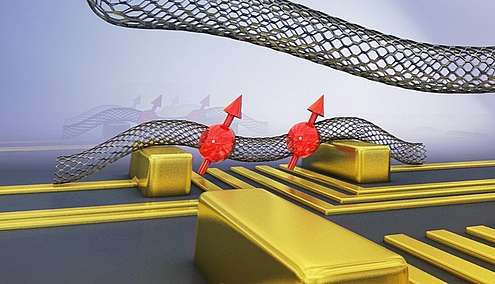Scientists realize quantum bit with a bent nanotube

One of the biggest challenges in quantum science is to build a functioning quantum bit, the basic element for the quantum computer. An important theoretical candidate for such a quantum bit is using a bent carbon nanotube. Scientists at the Delft University of Technology and the Foundation for Fundamental Research on Matter (FOM), led by Professor Leo Kouwenhoven, have succeeded for the first time to create a working quantum bit using a carbon nanotube. On July 28 they published their results in Nature Nanotechnology.
Quantum computer
Quantum computers have the advantage that they can be much faster than "ordinary" supercomputers for various calculations. An ordinary computer bit has the value '1 'or '0', but a quantum bit uses the state of a single electron, which due to the extraordinary properties of the quantum world can take both values at the same time. "We call that a 'superposition''' says PhD student Fei Pei who carried out part of the measurements. "The main problem that quantum physicists have to deal with is that the superposition can be disturbed quickly by external factors, for instance by other particles around the quantum bit."
Bent tubes
Carbon nanotubes of a few nanometers in diameter have exceptional properties that make them a very suitable material for hosting quantum bits, but so far no one could manipulate and 'read' a single electron in a nanotube. The scientists from Delft have achieved that. They were inspired by the work of colleagues from Copenhagen who showed in 2010 theoretically that the quantum state of an electron can be controlled in a bent nanotube, and carried on their own work from 2012. Back then the Delft scientists showed how to read the electron quantum states in a nanotube. Putting both ideas together created a 'functioning' quantum bit.
"The next challenge would be to improve the stability of this quantum bit as currently we can not maintain the superposition state long enough, "said Pei. "We will now focus on reducing the disturbance, so to extend the lifetime of the superposition".
More information: Nature Nanotechnology DOI: 10.1038/nnano.2013.140
Journal information: Nature Nanotechnology
Provided by Delft University of Technology













.jpg)






